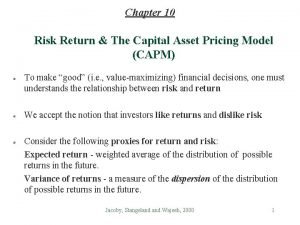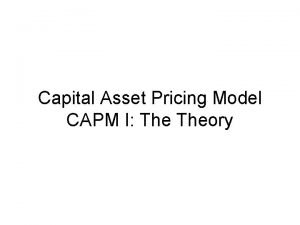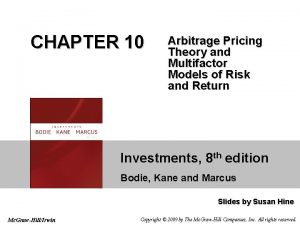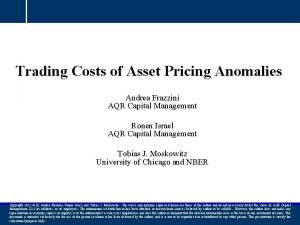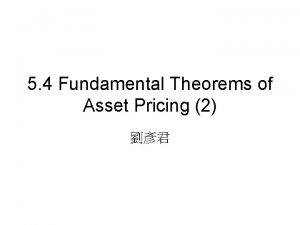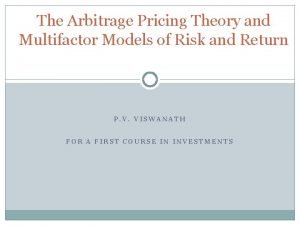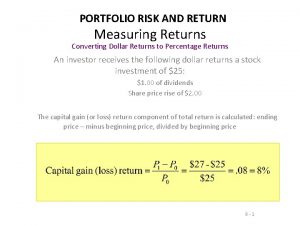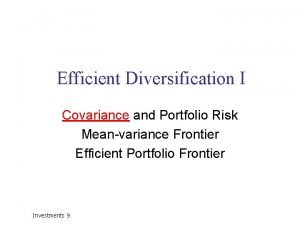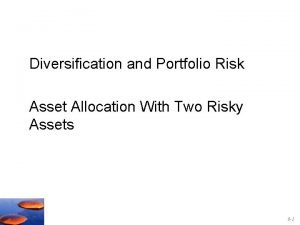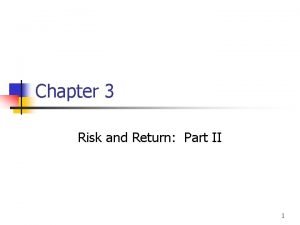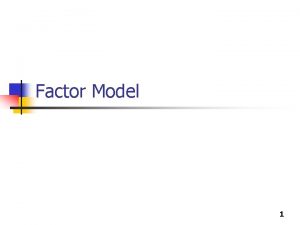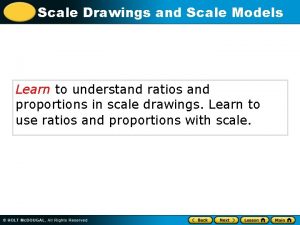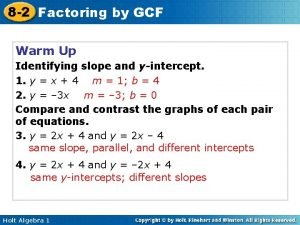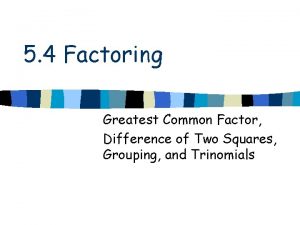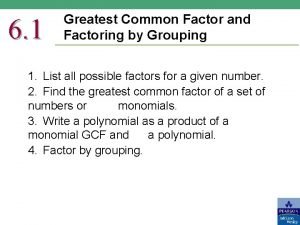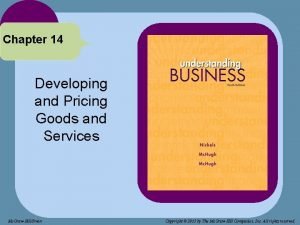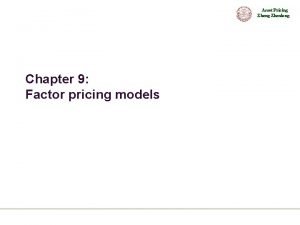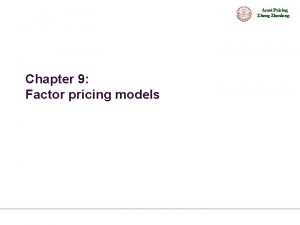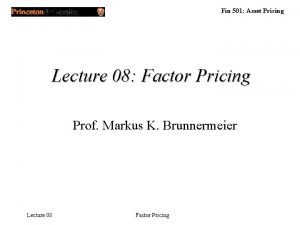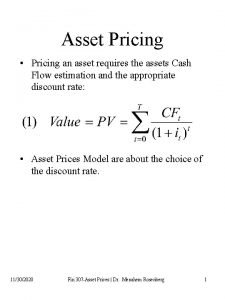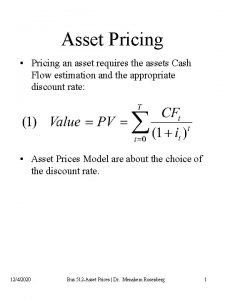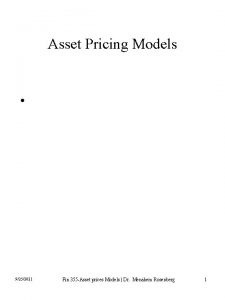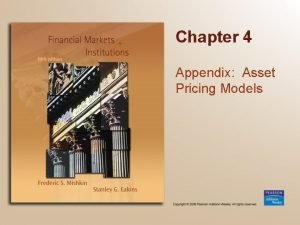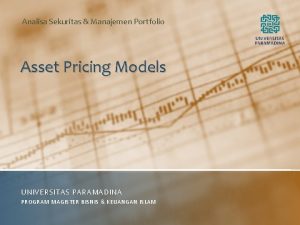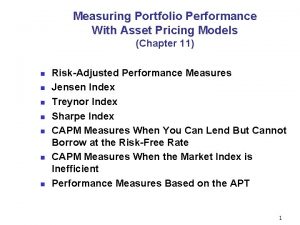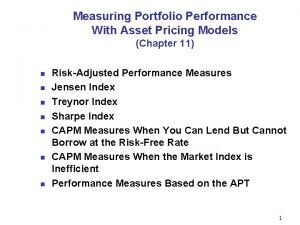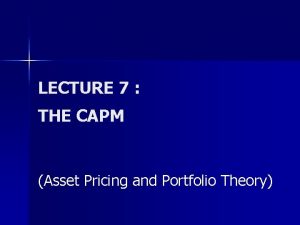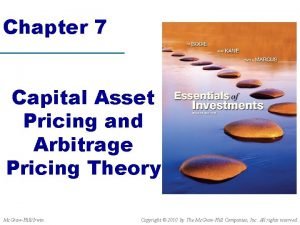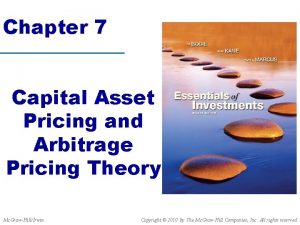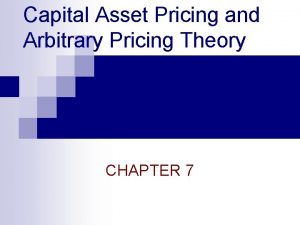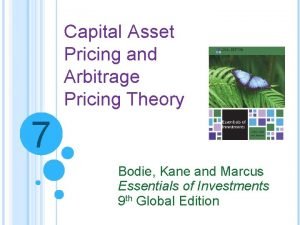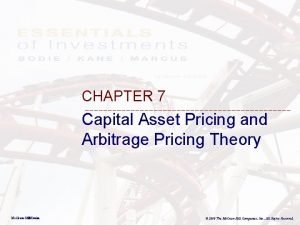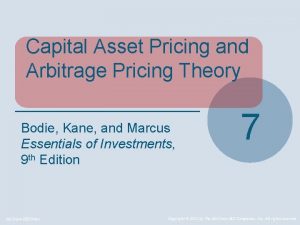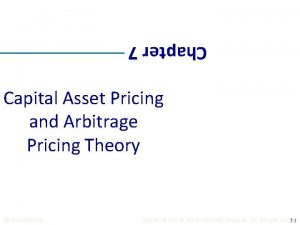LECTURE 8 FACTOR MODELS Asset Pricing and Portfolio






























- Slides: 30

LECTURE 8 : FACTOR MODELS (Asset Pricing and Portfolio Theory)

Contents The CAPM n Single index model n Arbitrage portfolio. S n Which factors explain asset prices ? n Empirical results n

Introduction n CAPM : Equilibrium model – One factor, where the factor is the excess return on the market. – Based on mean-variance analysis n Stephen Ross (1976) developed alternative model Arbitrage Pricing Theory (APT)

Single Index Model

Single Index Model Alternative approach to portfolio theory. Market return is the single index. Return on a stock can be written as : R i = a i + b i. R m a i = a i + ei Hence Ri = ai + bi. Rm + ei Equation (1) Assume : Cov(ei, Rm) = 0 E(eiej) = 0 for all i and j (i ≠ j)

Single Index Model (Cont. ) Obtain OLS estimates of ai, bi and sei (using OLS) n Mean return : ERi = ai + bi. ERm n Variance of security return : s 2 i = b 2 is 2 m + s 2 ei n Covariance of returns between securities : sij = bibjs 2 m

Portfolio Theory and the Market Model n n Suppose we have a 5 Stock Portfolio Estimates required – Traditional MV-approach n n n 5 Expected returns 5 Variances of returns 10 Covariances – Using the Single Index Model n 5 OLS regressions n 1 Expected return of the market portfolio 1 Variance of market return n – 5 alphas and 5 betas – 5 Variances of error term

Factor Models

Single Factor Model ER Slope = b a Factor

Factor Model : Example n n R i = a i + b i. F 1 + ei Example : Factor-1 is predicted rate of growth in industrial production i Stock 1 Stock 2 Stock 3 mean Ri 15% 21% 12% bi 0. 9 3. 0 1. 8

The APT : Some Thoughts n The Arbitrage Pricing Theory – New and different approach to determine asset prices. – Based on the law of one price : two items that are the same cannot sell at different prices. – Requires fewer assumptions than CAPM – Assumption : each investor, when given the opportunity to increase the return of his portfolio without increasing risk, will do so. n Mechanism for doing so : arbitrage portfolio

An Arbitrage Portfolio

Arbitrage Portfolio n Arbitrage portfolio requires no ‘own funds’ – Assume there are 3 stocks : 1, 2 and 3 – Xi denotes the change in the investors holding (proportion) of security i, then X 1 + X 2 + X 3 = 0 – No sensitivity to any factor, so that b 1 X 1 + b 2 X 2 + b 3 X 3 = 0 – Example : 0. 9 X 1 + 3. 0 X 2 + 1. 8 X 3 = 0 – (assumes zero non factor risk)

Arbitrage Portfolio (Cont. ) Let X 1 be 0. 1. n Then n n 0. 1 + X 2 + X 3 = 0 n 0. 09 + 3. 0 X 2 + 1. 8 X 3 = 0 – 2 equations, 2 unknowns. – Solving this system gives n X 2 = 0. 075 n X 3 = -0. 175

Arbitrage Portfolio (Cont. ) n Expected return X 1 ER 1 + X 2 ER 2 + X 3 ER 3 > 0 Here 15 X 1 + 21 X 2 + 12 X 3 > 0 (= 0. 975%) n Arbitrage portfolio is attractive to investors who – Wants higher expected returns – Is not concerned with risk due to factors other than F 1

Portfolio Stats / Portfolio Weights (Example) Weights Old Portf. Arbitr. Portf. New Portf. X 1 1/3 0. 1 0. 433 X 2 1/3 0. 075 0. 408 X 3 1/3 -0. 175 0. 158 ERp 16% 0. 975% 16. 975% bp 1. 9 0. 00 1. 9 sp 11% small approx 11% Properties

Pricing Effects n Stock 1 and 2 – – Buying stock 1 and 2 will push prices up Hence expected returns falls n Stock 3 n Buying/selling stops if all arbitrage possibilities are eliminated. Linear relationship between expected return and sensitivities ERi = l 0 + l 1 bi where bi is the security’s sensitivity to the factor. n – Selling stock 3 will push price down – Hence expected return will increase

Interpreting the APT n n ERi = l 0 + l 1 bi l 0 = rf l 1 = pure factor portfolio, p* that has unit sensitivity to the factor For bi = 1 ERp* = rf + l 1 or l 1 = ERp* - rf (= factor risk premium)

Two Factor Model : Example n Ri = ai + bi 1 F 1 + bi 2 F 2 + ei i ERi bi 1 bi 2 Stock 1 Stock 2 Stock 3 Stock 4 15% 21% 12% 8% 0. 9 3. 0 1. 8 2. 0 1. 5 0. 7 3. 2

Multi Factor Models n Ri = ai + bi 1 F 1 + bi 2 F 2 + … + bik Fk + ei n ERi = l 0 + l 1 bi 1 + l 2 bi 2 + … + lkbik

Identifying the Factors n Unanswered questions : – How many factors ? – Identity of factors (i. e. values for lamba) n Possible factors (literature suggests : 3 – 5) Chen, Roll and Ross (1986) n n Growth rate in industrial production Rate of inflation (both expected and unexpected) Spread between long-term and short-term interest rates Spread between low-grade and high-grade bonds

Testing the APT

Testing the Theory n n Proof of any economic theory is how well it describes reality. Testing the APT is not straight forward – theory specifies a structure for asset pricing – theory does not say anything about the economic or firm characteristics that should affect returns. n Multifactor return-generating process Ri = ai + S bij. Fj + ei n APT model can be written as ERi = rf + S bijlj

Testing the Theory (Cont. ) bij : are unique to each security and represent an attribute of the security Fj : any I affects more than 1 security (if not all). lj : the extra return required because of a security’s sensitivity to the jth attribute of the security

Testing the Theory (Cont. ) n Obtaining the bij’s – First method is to specify a set of attributes (firm characteristics) : bij are directly specified – Second method is to estimate the bij’s and then the lj using the equation shown earlier.

Principal Component Analysis (PCA) n n n Technique to reduce the number of variables being studied without losing too much information in the covariance matrix. Objective : to reduce the dimension from N assets to k factors Principal components (PC) serve as factors – First PC : (normalised) linear combination of asset returns with maximum variance – Second PC : (normalised) linear combination of asset returns with maximum variance of all combinations orthogonal to the first component

Pro and Cons of Principal Component Analysis n Advantage : – Allows for time-varying factor risk premium – Easy to compute n Disadvantage : – interpretation of the principal components, statistical approach

Summary n APT alternative approach to explain asset pricing – Factor model requiring fewer assumptions than CAPM – Based on concept of arbitrage portfolio n Interpretation : lamba’s are difficult to interpret, no economics about the factors and factor weightings.

References Cuthbertson, K. and Nitzsche, D. (2004) ‘Quantitative Financial Economics’, Chapters 7 n Cuthbertson, K. and Nitzsche, D. (2001) ‘Investments : Spot and Derivatives Markets’, Chapter 10. 5 (The Arbitrage Pricing Theory) n

END OF LECTURE
 Capital market line
Capital market line Capm assumptions
Capm assumptions Multifactor apt formula
Multifactor apt formula Capm xls
Capm xls Capm excel
Capm excel Abb ellipse
Abb ellipse Andrea frazzini aqr
Andrea frazzini aqr Fundamental theorem of asset pricing proof
Fundamental theorem of asset pricing proof Arbitrage pricing theory model
Arbitrage pricing theory model 01:640:244 lecture notes - lecture 15: plat, idah, farad
01:640:244 lecture notes - lecture 15: plat, idah, farad Variance of 3 asset portfolio formula
Variance of 3 asset portfolio formula Gmvp meaning
Gmvp meaning Portfolio variance formula
Portfolio variance formula Variance of 3 asset portfolio formula
Variance of 3 asset portfolio formula Modal and semi modals
Modal and semi modals Weebly teaching portfolio
Weebly teaching portfolio Customer portfolio management
Customer portfolio management Factor analysis lecture notes
Factor analysis lecture notes Form factor and crest factor
Form factor and crest factor Lcm for 4 and 12
Lcm for 4 and 12 Wacc preferred stock
Wacc preferred stock How to understand scale drawings
How to understand scale drawings Scale drawings and scale models
Scale drawings and scale models Factoring by gcf
Factoring by gcf Factor out the greatest common factor
Factor out the greatest common factor Factor-isolating question
Factor-isolating question Factor by greatest common factor
Factor by greatest common factor Developing and pricing goods and services
Developing and pricing goods and services Dtl dta
Dtl dta Premier asset management llc
Premier asset management llc Human resource cost accounting
Human resource cost accounting
